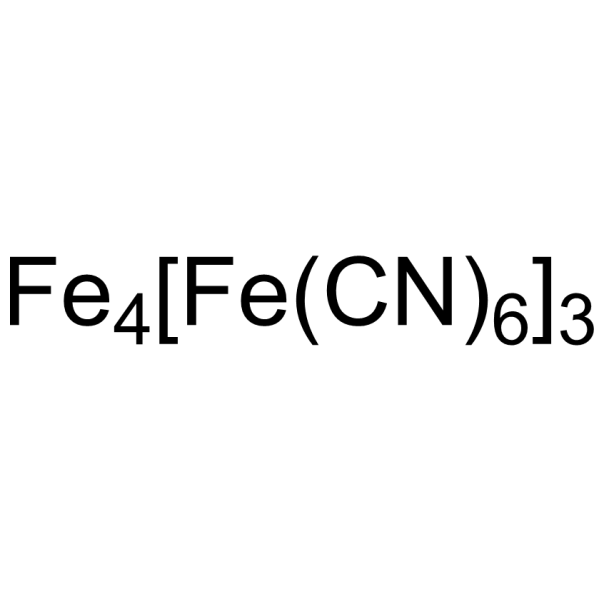CHEMICAL IDENTIFICATION
-
RTECS NUMBER :
-
LJ8200000
-
CAS REGISTRY NUMBER :
-
14038-43-8
-
LAST UPDATED :
-
199710
-
DATA ITEMS CITED :
-
9
-
MOLECULAR FORMULA :
-
C18-Fe3-N18.4Fe
HEALTH HAZARD DATA
ACUTE TOXICITY DATA
-
TYPE OF TEST :
-
LD - Lethal dose
-
ROUTE OF EXPOSURE :
-
Oral
-
SPECIES OBSERVED :
-
Rodent - rat
-
DOSE/DURATION :
-
>8 gm/kg
-
TOXIC EFFECTS :
-
Details of toxic effects not reported other than lethal dose value
-
REFERENCE :
-
GTPZAB Gigiena Truda i Professional'nye Zabolevaniya. Labor Hygiene and Occupational Diseases. (V/O Mezhdunarodnaya Kniga, 113095 Moscow, USSR) V.1-36, 1957-1992. For publisher information, see MTPEEI Volume(issue)/page/year: 35(1),35,1991
-
TYPE OF TEST :
-
LD50 - Lethal dose, 50 percent kill
-
ROUTE OF EXPOSURE :
-
Intraperitoneal
-
SPECIES OBSERVED :
-
Rodent - rat
-
DOSE/DURATION :
-
2100 mg/kg
-
TOXIC EFFECTS :
-
Behavioral - somnolence (general depressed activity) Lungs, Thorax, or Respiration - dyspnea Liver - other changes
-
REFERENCE :
-
GTPZAB Gigiena Truda i Professional'nye Zabolevaniya. Labor Hygiene and Occupational Diseases. (V/O Mezhdunarodnaya Kniga, 113095 Moscow, USSR) V.1-36, 1957-1992. For publisher information, see MTPEEI Volume(issue)/page/year: 35(1),35,1991
-
TYPE OF TEST :
-
LDLo - Lowest published lethal dose
-
ROUTE OF EXPOSURE :
-
Intratracheal
-
SPECIES OBSERVED :
-
Rodent - rat
-
DOSE/DURATION :
-
250 mg/kg
-
TOXIC EFFECTS :
-
Behavioral - somnolence (general depressed activity) Lungs, Thorax, or Respiration - dyspnea Kidney, Ureter, Bladder - other changes
-
REFERENCE :
-
GTPZAB Gigiena Truda i Professional'nye Zabolevaniya. Labor Hygiene and Occupational Diseases. (V/O Mezhdunarodnaya Kniga, 113095 Moscow, USSR) V.1-36, 1957-1992. For publisher information, see MTPEEI Volume(issue)/page/year: 35(1),35,1991
-
TYPE OF TEST :
-
LD - Lethal dose
-
ROUTE OF EXPOSURE :
-
Oral
-
SPECIES OBSERVED :
-
Rodent - mouse
-
DOSE/DURATION :
-
>8 gm/kg
-
TOXIC EFFECTS :
-
Details of toxic effects not reported other than lethal dose value
-
REFERENCE :
-
GTPZAB Gigiena Truda i Professional'nye Zabolevaniya. Labor Hygiene and Occupational Diseases. (V/O Mezhdunarodnaya Kniga, 113095 Moscow, USSR) V.1-36, 1957-1992. For publisher information, see MTPEEI Volume(issue)/page/year: 35(1),35,1991
-
TYPE OF TEST :
-
LD50 - Lethal dose, 50 percent kill
-
ROUTE OF EXPOSURE :
-
Intraperitoneal
-
SPECIES OBSERVED :
-
Rodent - mouse
-
DOSE/DURATION :
-
2 gm/kg
-
TOXIC EFFECTS :
-
Behavioral - somnolence (general depressed activity) Lungs, Thorax, or Respiration - dyspnea Blood - changes in spleen
-
REFERENCE :
-
GTPZAB Gigiena Truda i Professional'nye Zabolevaniya. Labor Hygiene and Occupational Diseases. (V/O Mezhdunarodnaya Kniga, 113095 Moscow, USSR) V.1-36, 1957-1992. For publisher information, see MTPEEI Volume(issue)/page/year: 35(1),35,1991
-
TYPE OF TEST :
-
LD - Lethal dose
-
ROUTE OF EXPOSURE :
-
Oral
-
SPECIES OBSERVED :
-
Rodent - rabbit
-
DOSE/DURATION :
-
>8 gm/kg
-
TOXIC EFFECTS :
-
Details of toxic effects not reported other than lethal dose value
-
REFERENCE :
-
GTPZAB Gigiena Truda i Professional'nye Zabolevaniya. Labor Hygiene and Occupational Diseases. (V/O Mezhdunarodnaya Kniga, 113095 Moscow, USSR) V.1-36, 1957-1992. For publisher information, see MTPEEI Volume(issue)/page/year: 35(1),35,1991 *** NIOSH STANDARDS DEVELOPMENT AND SURVEILLANCE DATA *** NIOSH OCCUPATIONAL EXPOSURE SURVEY DATA : NOES - National Occupational Exposure Survey (1983) NOES Hazard Code - T1624 No. of Facilities: 5778 (estimated) No. of Industries: 67 No. of Occupations: 58 No. of Employees: 85363 (estimated) No. of Female Employees: 20494 (estimated)
|





